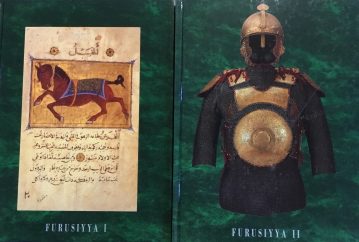Furusiyya [Horsemanship], The Horse And The Art of The Near East. TWO VOLUMES.
Alexander, David (Editor).
Synopsis
An illustrated and well documented study on the horse in general, and Arab horse and its relation to Arab history in particular. It starts with some of the earliest representations of horses and chariots from he ancient city of Ur in Mesopotamia. Other early pieces include cuneiform texts on horse care from the Hittite and Assyrians period; sculpture and representations of chariots from Dynastic Egypt; the bronze bits and horse trappings from Urartu and Luristan. As well as the earliest surviving saddle and horse trappings dating to 500 B.C. from the frozen Schythian graves at Pazyryk and a head of one of the sculptured horses from the Temple of Zeus at Perganum. Other magnificent pieces include a Byzantine ivory representing a chariot race in the hippodrome at Constantinople; a silver ‘hunting’ plate probably made for a Sasanian ruler in Iran; horse models and sculptures from various Central Asian cites; equestrian models, including several Benin bronzes from Africa; an alabaster stele showing a horse and camel from south Arabia, as well as recently excavated finds from other pre-Islamic sites in Saudi Arabia and Sharjah.
Many of the objects are from the Islamic period. These are intended not only to illustrate themes of horsemanship, but also to show some of the great masterpieces of Islamic art. Among the highlights are the great Mamluk tisht, basin, and the huqqa, pyxis, made for al-Mughira ibn Abd al-Rahman in 357/968 from the Musee de Louvre; a celestial globe dated 622/1225-26 from the Museo di Capodimonte in Naples; the Padshah-nama from the Royal Library at Windsor; the Kitab al-Aghani of 610/1219 from the Royal Library in Copenhagen; a ceramic dish showing a polo player and dated 60/1207 from the Victoria and Albert Museum; several 14th and 15th century Album paintings from the Staatsbibliothek in Berlin, a number of finely crafted and decorated saddles and horse trappins from the Kunsthistorisches Museum in Vienna; and a large number of magnificent objects and manuscripts from the British Museum and the British Library.






